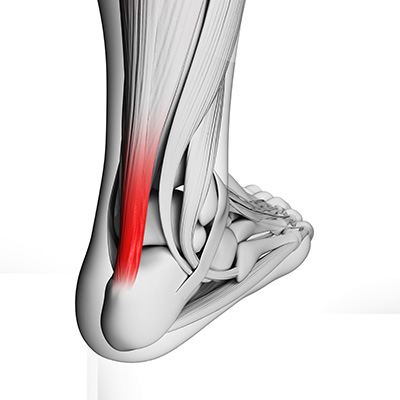What Is the Achilles Tendon?
The Achilles tendon is the longest and strongest tendon in the human body. It exerts more force per area than any other tendon. It begins from three muscles in the leg and attaches to the heel bone to help with the push-off phase of gait.
Achilles Tendonitis and Achilles Tendonosis
 Two common disorders that occur with the Achilles tendon are tendonitis and tendonosis.
Two common disorders that occur with the Achilles tendon are tendonitis and tendonosis.
Achilles tendonitis is an inflammation of the Achilles tendon that typically develops with increased activity and stress. It can eventually become tendonosis as the microscopic structure of the Achilles tendon changes. The collagen fibers can begin to harden and sometimes calcify. In addition, the fibers can begin to tear and ultimately rupture.
Causes
The majority of cases of Achilles tendon problems are associated with “overuse.” Often times we see weekend warrior type athletes that have inciting injuries from basketball, running or other sports. These ongoing stresses can cause the tendon to enter an inflammatory phase that is hard to recover from and/or repair without medical intervention. Other causes can include tight calf muscles or pronated foot structures.
Symptoms
The symptoms associated with Achilles tendonitis and tendonosis include:
• Pain, stiffness, and aching can occur. Some patients experience increased morning pain that loosens with activities.
• Tenderness, especially with squeezing of the tendon. This can occur along the course of the tendon but is usually in the mid-substance of the tendon.
• When the disorder progresses to degeneration, the tendon may become enlarged and may develop nodules in the area where the tissue is damaged.
• With increased activities, swelling can become a problem, and with swelling risk of rupture increases
Diagnosis
In diagnosing Achilles tendonitis or tendonosis, your foot and ankle doctor will perform a physical exam. We may also take an X-ray or use ultrasound. Sometimes additional studies are needed, such as an MRI.
Treatment
Treatment approaches for Achilles tendonitis or tendonosis are selected on the basis of how long the injury has been present and the degree of damage to the tendon. It is best to discuss your options with your foot and ankle doctor.
• Immobilization
• Bracing
• Icing
• NSAIDS
• Prescription Orthotics
• Physical Therapy
When is Surgery Needed?
If non-surgical approaches fail to restore the tendon to its normal condition, surgery may be necessary. The foot and ankle surgeon will select the best procedure to repair the tendon, based upon the extent of the injury, the patient’s age and activity level, and other factors.






